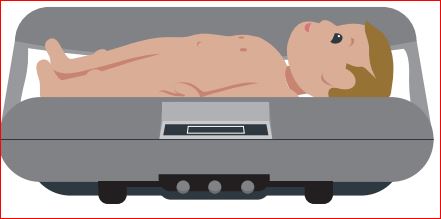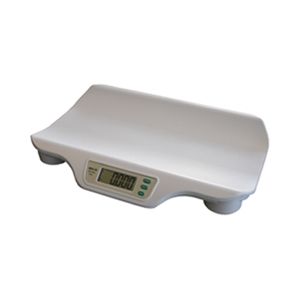A digital baby scale is a specialized weighing device designed for accurately measuring the weight of infants and young children. It utilizes digital technology to provide precise weight readings, making it useful for monitoring the growth and development of babies. Digital baby scales often come with features that enhance their functionality and usability.
Common Features of Baby Weighing Scales
When using a digital baby scale, it’s essential to follow the manufacturer’s instructions carefully to ensure accurate and safe measurements. Regularly monitoring your baby’s weight can provide valuable insights into their growth and development, but it’s always a good idea to consult with a healthcare professional if you have any concerns about your baby’s weight or growth trajectory.
Digital Display:
The most distinguishing feature of a digital baby scale is its digital display, which shows the weight measurement in a clear and easy-to-read format.
Tare Function:
The tare function allows you to place a soft towel or blanket on the scale’s surface before placing the baby on it. The scale then subtracts the weight of the blanket to provide a more accurate measurement of the baby’s weight.
Hold Function:
This feature freezes the weight reading on the display even after the baby has been removed from the scale. This is helpful when the baby is moving around, making it difficult to get an immediate stable reading.
Measurement Units:
Digital baby scales often allow you to switch between different units of measurement, such as pounds (lb) and kilograms (kg), depending on your preference.
Memory Function:
Some advanced models have memory storage capabilities, allowing you to track and compare your baby’s weight over time. This is particularly useful for monitoring growth patterns and ensuring the baby is reaching healthy milestones.
Battery Operation:
Digital baby scales typically operate on batteries, making them portable and suitable for use in various locations within the home.
Safety Features:
Many digital baby scales are designed with curved or contoured surfaces to ensure the baby’s safety and comfort during weighing. Some scales also include non-slip surfaces to prevent accidents.
Weight Capacity:
Baby scales usually have weight capacities that are well-suited for infants and toddlers. It’s important to choose a scale with a capacity that accommodates your child’s weight.
Types of Baby Weighing Scales

There are several types of baby weighing scales available on the market, each designed to meet specific needs and preferences. Here are some common types:
Digital Baby Weighing Scale:
These scales are equipped with digital displays that provide accurate and easy-to-read measurements. They often have features like tare function (to subtract the weight of a blanket or clothing) and memory recall.
Mechanical Baby Weighing Scale:
Also known as analog scales, these use a spring mechanism to measure the weight. They usually have a rotating dial that displays the weight. While they can be less precise than digital scales, they are often more affordable.
Convertible Baby Weighing Scale:
Some scales can be used as both a baby weighing scale and a toddler scale by adding a detachable tray. This type of scale provides versatility and can grow with your child.
Chair-Style Baby Weighing Scale:
These scales have a seat or chair-like structure where the baby can be comfortably placed for weighing. This design is particularly helpful for keeping the baby secure and calm during the weighing process.
Hanging Baby Weighing Scale:
These scales use a sling or harness to suspend the baby from a measurement point. They are often used in medical settings and are useful for babies who might not be comfortable lying down.
In-Built Baby Weighing Scale:
Some baby changing tables or cribs come with built-in weighing scales. This makes it convenient to measure the baby’s weight during diaper changes or while they’re lying down.
Wireless and Smart Baby Weighing Scale:
These scales can connect to your smartphone or other devices via Bluetooth or Wi-Fi, allowing you to track your baby’s weight over time using dedicated apps. They often come with additional features like growth charts and data analysis.
Travel Baby Weighing Scale:
Designed for portability, these scales are lightweight and compact, making them convenient for families on the go.
Pediatric Scale:
While not exclusively for babies, pediatric scales are designed to accommodate both infants and toddlers. They often have features like stability enhancers and safety rails to keep the child secure.
When choosing a baby weighing scale, consider factors like accuracy, ease of use, comfort for the baby, durability, and any additional features that might be important for you. It’s also a good idea to consult with your pediatrician or healthcare provider for recommendations on the most suitable type of scale for your baby’s needs.
Anyscale’s best Baby Scales –
EBSL, BABY SCALE
Parents who want accurate weight readings when measuring their infant’s growth should look no further than the EBSL, Baby Scale by Anyscale. This product is designed for convenient use, providing an ideal solution for tracking your baby’s growth in-between doctor visits. Weighing infants has never been easier – with maximum accuracy guaranteed every time.
The Baby Scale is crafted with precision that is unrivaled in the market today. Its slim-line design and ergonomic shape is perfect for a newborn baby. The infant carrying cradle even offers comfortable support while providing the best accuracy. The detachable control panel gives you easy access to the control buttons, and the display features all the information you need.

Calibration Process of Baby Weighing Scales
Calibrating a baby scale refers to the process of adjusting and setting the scale to ensure accurate measurements of an infant’s weight. Infant scales are used to monitor the growth and development of babies, especially during the early stages of life. Proper calibration is crucial to ensure that the scale provides consistent and reliable measurements.
Here’s a general overview of the calibration process for baby scales, especially those used in healthcare settings for weighing infants:
1. Gather Necessary Equipment:
You’ll need the following equipment to calibrate a baby scale:
Standard weights (calibration weights) of known and accurate mass.
Non-abrasive cleaning materials, like a soft cloth, to clean the scale.
2. Choose Calibration Weights:
Select calibration weights that are appropriate for the range of weights the baby scale will measure. These weights should be traceable to a recognized national or international standard.
3. Clean the Scale:
Before calibration, ensure the scale’s weighing platform is clean and free from any debris or substances that could affect accuracy.
4. Zero Calibration (Tare):
Begin by performing a zero calibration (tare) on the scale. This compensates for any weight on the scale’s platform that isn’t part of the baby’s weight. Make sure the scale reads zero when there is nothing on the platform.
5. Performing Calibration:
Follow these steps to calibrate the baby scale:
- Place a calibration weight with a known mass on the scale’s platform. Ensure the weight is centered to avoid uneven loading.
- Record the weight displayed on the scale.
- Compare the displayed weight to the known mass of the calibration weight. If there’s a discrepancy, the scale requires adjustment.
- Some baby scales have adjustment mechanisms (like calibration screws) that allow you to adjust the scale’s reading to match the actual weight of the calibration mass.
6. Repeat Calibration:
For higher accuracy, you may need to repeat the calibration process using multiple calibration weights, especially if the scale covers a wide range of weights.
7. Final Verification:
After adjusting the scale, verify its accuracy by placing different calibration weights of known masses on the scale and comparing the readings to the expected values.
8. Record Calibration:
Document the calibration process, including the date, calibration weights used, adjustments made (if any), and the final accuracy verification.
9. Regular Maintenance:
Calibration is not a one-time task. Baby scales should be regularly calibrated to ensure ongoing accuracy. The frequency of calibration depends on how often the scale is used and the manufacturer’s recommendations.
Remember that proper calibration is essential for accurate measurements, especially when dealing with sensitive measurements involving infants’ health. If you’re not familiar with calibration procedures, it’s advisable to seek assistance from professionals or individuals with expertise in calibration.









